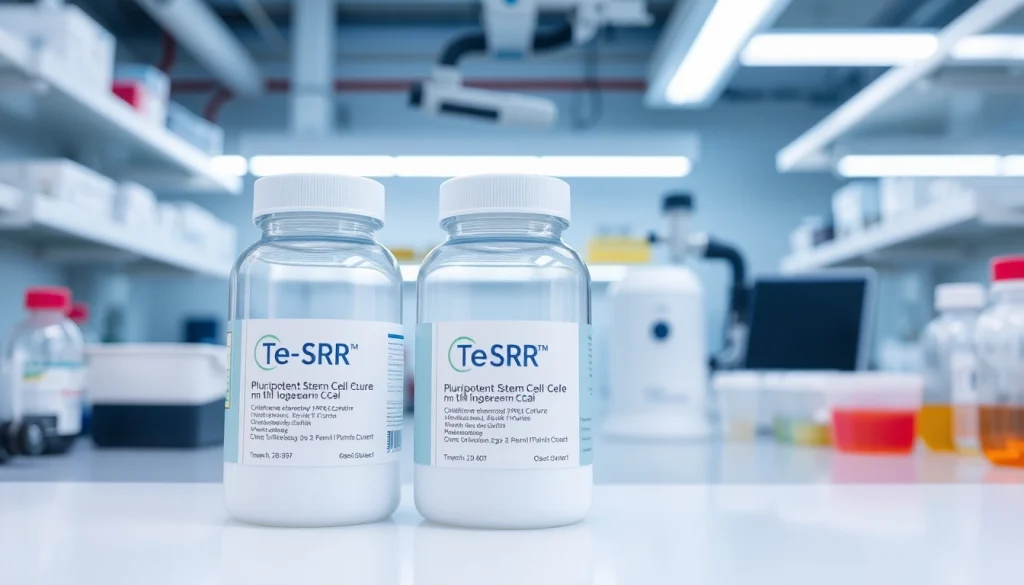
Understanding TeSR™ Feeder-Free Media
In the realm of stem cell research, the significance of effective and reliable culture media cannot be overstated. The TeSR™ family of feeder-free media has made remarkable strides in enabling researchers to maintain human pluripotent stem cell (hPSC) cultures under optimal conditions. These products, developed with rigorous quality control measures and scientifically backed formulations, allow for the seamless maintenance, differentiation, and reprogramming of embryonic stem (ES) cells and induced pluripotent stem (iPS) cells. This article delves into the fundamental aspects of TeSR™ media, their applications, and best practices associated with their usage in pluripotent stem cell research.
What is TeSR™ Medium?
TeSR™ medium is a proprietary formulation designed for the cultivation of human pluripotent stem cells in a feeder-free environment. Pioneered by researchers in Dr. James Thomson’s lab, the initial formulation, mTeSR™1, represented a significant leap forward from conventional methods that relied on feeder cells for maintaining cell pluripotency. This innovation eliminated the variability associated with feeder layers and allowed for better standardization in cell culture.
The TeSR™ media series has since expanded, incorporating modifications and innovations that enhance usability and performance. This includes the introduction of mTeSR™ Plus, TeSR™-E8™, and TeSR™-AOF, each tailored to specific research needs and ensuring the highest quality of hPSC cultures.
Key Components and Their Functions
The formulation of TeSR™ mediums is based on a combination of essential growth factors, proteins, and additives that collectively support the optimal proliferation and maintenance of hPSCs. Key components include:
- FGF2 (Fibroblast Growth Factor 2): A critical growth factor that promotes cell proliferation and sustains pluripotency.
- Transforming Growth Factor β (TGF-β): Involved in cellular signaling, TGF-β aids in maintaining the stemness of hPSCs.
- Insulin: Acts as a nutrient and growth factor, supporting cell metabolism and proliferation.
- Various Cytokines: These play multifaceted roles in regulating cell behavior, growth, and differentiation potential.
The precise concentration and combination of these components are critical in maintaining cell morphology, viability, and functionality during in vitro culture.
Benefits of Feeder-Free Culturing
Utilizing feeder-free media such as TeSR™ offers multiple advantages over traditional culture systems:
- Enhanced Reproducibility: The standardized components of TeSR™ media minimize variability between batches, making experimental outcomes more consistent.
- Reduced Contamination Risk: Eliminating feeder layers reduces microbial contamination risks and minimizes the likelihood of introducing xenogenic components.
- Clear Observation of Cells: Culturing cells without feeders allows for better visualization and assessment of cell health and morphology under a microscope.
- Flexible Maintenance Protocols: Many TeSR™ media formulations support reduced media change frequency, which is beneficial for optimizing laboratory workflows.
Types of TeSR™ Media and Their Applications
The TeSR™ media family encompasses a variety of formulations tailored to meet specific research needs. Each type is engineered with distinct features and applications.
Overview of mTeSR™ Plus Variants
mTeSR™ Plus represents an evolution of the mTeSR™1 formulation and offers enriched composition for enhanced performance. Its key features include:
- Stabilized Components: mTeSR™ Plus incorporates stabilized forms of growth factors, which help maintain pH levels, reduce acidification, and ensure cell quality during experimental procedures.
- Weekend-Free Culture: The formulation allows for extended periods without media change, enabling researchers to maintain cultures over weekends without compromising cell health.
- cGMP Compliance: mTeSR™ Plus is manufactured under a current Good Manufacturing Practice (cGMP) compliant facility, ensuring the highest levels of quality and safety.
These attributes make mTeSR™ Plus particularly suitable for laboratories focused on high-throughput screening and longitudinal studies.
Comparison: mTeSR™ vs. Other Media
While mTeSR™ is widely recognized as one of the leading feeder-free media, it is essential to understand how it compares to other formulations:
- mTeSR™1: The original formulation, foundational for the development of subsequent TeSR™ variants, offers fundamental support for hPSC maintenance.
- TeSR™-E8™: This formulation emphasizes simplicity, containing only the most critical components needed for hPSC maintenance, making it ideal for researchers looking for a streamlined medium.
- TeSR™-AOF: Specifically designed to be animal-origin free, TeSR™-AOF provides peace of mind concerning contamination risks for sensitive applications.
This variety of options allows researchers to select the most appropriate medium based on their specific project needs and regulatory requirements.
Specific Uses for iPS Cell Reprogramming
The process of inducing pluripotency in somatic cells through reprogramming is critical in regenerative medicine. TeSR™ media, particularly ReproTeSR™, are expressly formulated for optimal reprogramming:
- ReproTeSR™: This medium is designed to maximize the efficiency and quality of iPS cell generation from fibroblasts and other cell types, supporting enhanced pluripotency and self-renewal capabilities.
- Specific Kits: Supplementary kits, such as the Erythroid Progenitor Reprogramming Kit, provide targeted solutions for deriving specific lineages from iPS cells, aligning with the goals of precision medicine.
Best Practices for Culturing Pluripotent Stem Cells
Successfully culturing hPSCs requires adherence to established best practices that enhance cell viability and function. Institutions dedicated to stem cell research can benefit from implementing these protocols.
Maintaining Optimal Cell Culture Conditions
Optimal culture conditions encompass various factors, including:
- Temperature Control: Cultures should be maintained at 37°C, with careful monitoring to prevent temperature fluctuations.
- CO2 Levels: A humidified atmosphere with 5% CO2 is crucial for maintaining media pH and supporting cell growth.
- Subculturing Techniques: Efficient passaging occurs when cultures reach 70-80% confluence, utilizing techniques such as enzymatic dissociation for optimal yield.
Batch-to-Batch Consistency and Quality Control
Maintaining batch-to-batch consistency is vital in any scientific investigation. Practices that foster consistent quality include:
- Rigorous Testing: Conducting regular assessments of cell morphology and growth rates helps ensure that media formulations are performing as expected.
- Documentation: Meticulously recording data regarding culture conditions, passage numbers, and cell line characteristics allows for reproducibility across experiments.
Implementing cGMP in Cell Culturing
Adhering to current Good Manufacturing Practices (cGMP) plays a critical role in cell culture, especially for research with potential clinical applications:
- Quality Assurance: Implementing cGMP guidelines ensures all products used in research are manufactured to the highest standards, minimizing contamination risks.
- Traceability: Documenting every step of the procurement and usage process fosters trust in the validity of research outcomes by enabling researchers to trace back every element of their experiments.
Challenges and Solutions in hPSC Differentiation
Differentiating hPSCs can be fraught with challenges, including variable outcomes and inconsistency across cultures. However, tools and methods exist to improve success rates.
Common Issues Faced During Differentiation
The journey from pluripotent cells to specialized cell types is complex, often exemplified by:
- Inconsistent Differentiation: Variability in outcomes can occur due to differences in pre-culture conditions or sub-optimal differentiation protocols.
- Cell Line Dependency: Not all hPSC lines behave the same, leading to difficulties when attempting to standardize differentiation protocols.
Utilizing STEMdiff™ for Improved Outcomes
To counter these challenges, the STEMdiff™ suite of products has been developed:
- Dedicated Differentiation Media: These media formulations are designed to optimize the differentiation process, supporting transitions from hPSCs to specific lineages.
- Protocols and Kits: STEMdiff™ provides tested protocols and necessary reagents to standardize and enhance outcomes across various differentiation aims.
Expert Interviews on Successful Differentiation Techniques
Insights from leading experts in the field can significantly enhance the understanding and implementation of successful differentiation protocols. Interviews with researchers like Dr. Joseph C. Wu, Dr. Andrew Elefanty, Dr. David Hay, and Dr. Robert Zweigerdt have unveiled critical insights into:
- Differentiating to Hematopoietic Cells: Strategies to achieve reliable hematopoietic differentiation.
- Differentiating to Definitive Endoderm: Techniques for guiding stem cells towards endodermal fates.
- Scale-Up and Bioreactor Culture: Processes to efficiently scale up differentiation within bioreactor systems.
- Differentiating to Cardiomyocytes: Pathways to derive heart cells from pluripotent sources.
Future Directions in Stem Cell Media Research
As the field of stem cell research continues to evolve, innovation in culture media remains a focal point. Understanding emerging trends will prepare researchers for future challenges.
Innovations in TeSR™ Formulations
The future of TeSR™ media looks promising with ongoing efforts to refine formulations further:
- Enhanced Performance Metrics: Continuous optimization of growth factors and anti-apoptotic agents directly impacts cell viability and differentiation quality.
- Sustainable Production Methods: Innovations aimed at reducing the environmental impact of media production while maintaining the highest quality standards.
Impact of Research on Clinical Applications
Current research directly affects the clinical applicability of stem cell therapies:
- Personalized Medicine: Development of patient-specific iPS cells holds potential for tailored disease treatments.
- Regenerative Medicine: Generated cell types from differentiated hPSCs can serve as therapy sources for a variety of conditions, ranging from neurodegenerative diseases to cardiac repair.
- Drug Development: Utilizing differentiated hPSCs enables better modeling of human diseases for pharmaceutical research, improving drug discovery processes.
Collaborative Efforts in Stem Cell Advancements
Collaboration among researchers, institutions, and industries is vital for advancing stem cell research:
- Consortiums and Networks: Joining forces allows for knowledge sharing, pooling resources, and accelerating research findings to translate into clinical settings.
- Interdisciplinary Approaches: Engaging with bioinformatics, engineering, and material sciences enriches stem cell research with new methodologies and technologies.






